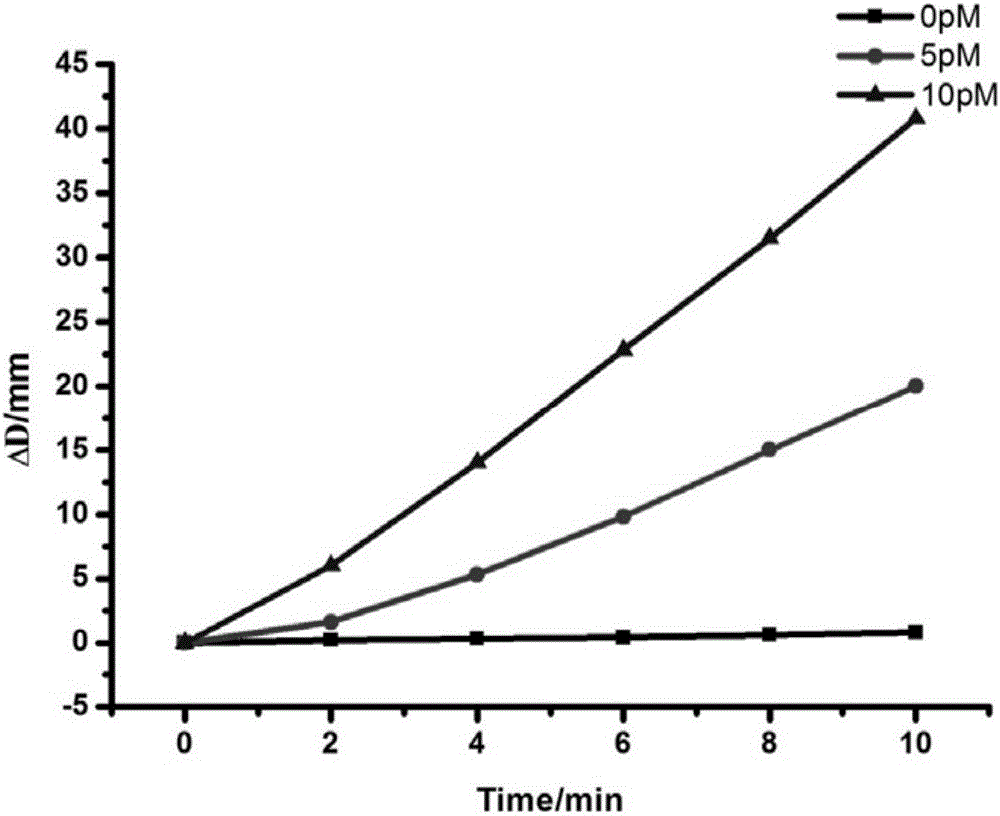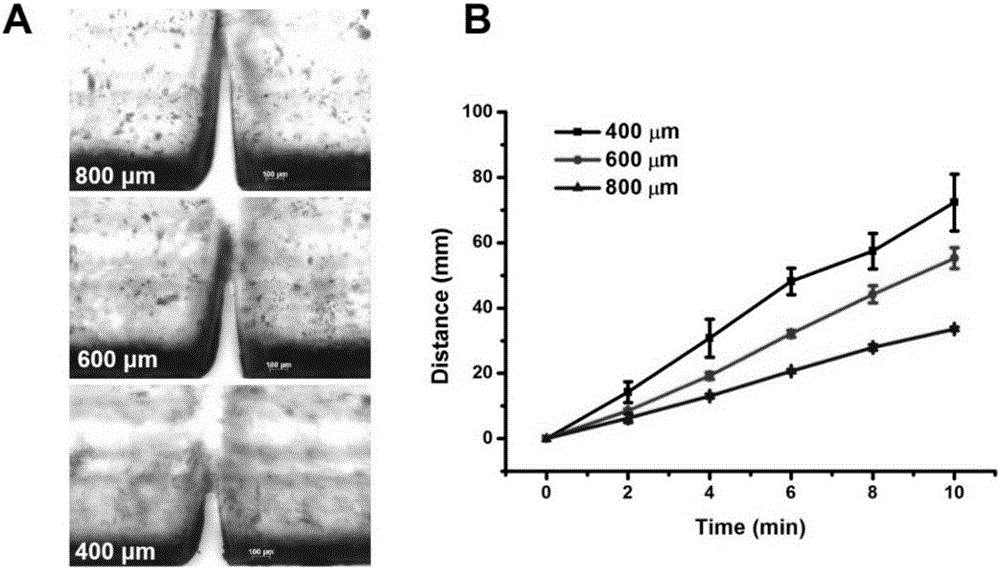Integrated ELISA (Enzyme-Linked Immuno Sorbent Assay) chip based on distance detection targets and detection method thereof
A distance detection and target technology, applied in measurement devices, instruments, scientific instruments, etc., can solve the problems of complex immune response operation, high cost of experimental methods, expensive equipment and other problems, and achieve reliable detection results, high sensitivity, and reaction process. simple effect
- Summary
- Abstract
- Description
- Claims
- Application Information
AI Technical Summary
Problems solved by technology
Method used
Image
Examples
Embodiment 1
[0036] Example 1: Fabrication of chips
[0037] According to the chip design of Auto CAD in the computer, the required microstructures and microchannels are produced by laser etching on the PMMA material. The middle layer contains 11 circular holes, 9 elliptical holes, and air column channels. The upper layer is the water phase addition channel and the sample injection hole, and the bottom layer is the oil phase addition channel. The thickness of the three-layer chip is 2.2mm. The light-cut PMMA sheet is used to bond the three layers together by means of hot keys and summation. In order to prevent capillary action, the bonded chip channel was incubated with fluorine oil, and after the fluorine oil evaporated overnight, the chip was ready for use.
[0038] Specifically, see Figure 13 , the chip includes an upper layer 1, a middle layer 2 and a lower layer 3, wherein the middle layer 2 is provided with a row of cavities alternately arranged by circular holes and elliptical h...
Embodiment 2
[0043] Example 2: Synthesis and purification of nucleic acid molecules modified with biotin groups and sulfhydryl groups
[0044] Using ordinary CPG as a solid phase carrier, and using DNA monomer bases as raw materials, the sequence DNAs in Table 1 were synthesized from the 3' end to the 5' end on a DNA synthesizer. The specific synthesized sequences are shown in Table 1. Biotin-modified CPG is used as a solid-phase carrier, and DNA monomer bases are used as raw materials to synthesize from the 3' end to the 5' end on a DNA synthesizer, and finally the 5' end is modified to modify the sulfhydryl group. After the synthesis, the above-mentioned CPG was transferred to a 2 mL clean and sterilized Eppendorf tube, 0.5 mL of methylamine: ammonia water = 1:1 solution was added, and the DNA was cleaved from the CPG at 65° C. for 30 min by ammonolysis. After the aminolysis, the supernatant was extracted, and the CPG was washed with a small amount of ultrapure water, and the supernatant...
Embodiment 3
[0048] Example 3: Synthesis and modification of PtNPs
[0049] 100 μL of freshly prepared 0.4M ascorbic acid solution was added to 1 mL of chloroplatinic acid solution with a concentration of 1 mM, and quickly placed in a constant temperature dry bath at 80 °C for 30 min to obtain PtNPs with a size of 30 nm. In order to use PtNPs for subsequent immune responses, biomolecular modification is required. In this paper, SH-PEG-biotin linker was used to modify PtNPs to obtain biotinylated PtNPs (biotin-PtNPs). The specific operation is to add 10 μL of 1% Tween-20 and 5 μL of 100 μM mPEG-SH (MW ~ 5KD) to 1 mL of 4.5 nM PtNPs, vortex and mix, and then add 10 μL of 120 μM SH-PEG-biotinlinker and 50 μL 0.2 M H3PO4 solution, vortex mixed and react at 37°C for 1 h. After the reaction, wash with PBS solution (pH 7.4) containing 0.1% Tween-20 and 0.5% BSA at 13,000 rpm for 3 times, 4 min each time, and finally resuspend in 1 mL of the above solution to obtain a final concentration of 2.5 ...
PUM
| Property | Measurement | Unit |
|---|---|---|
| Thickness | aaaaa | aaaaa |
| Diameter | aaaaa | aaaaa |
Abstract
Description
Claims
Application Information
 Login to View More
Login to View More - R&D
- Intellectual Property
- Life Sciences
- Materials
- Tech Scout
- Unparalleled Data Quality
- Higher Quality Content
- 60% Fewer Hallucinations
Browse by: Latest US Patents, China's latest patents, Technical Efficacy Thesaurus, Application Domain, Technology Topic, Popular Technical Reports.
© 2025 PatSnap. All rights reserved.Legal|Privacy policy|Modern Slavery Act Transparency Statement|Sitemap|About US| Contact US: help@patsnap.com



